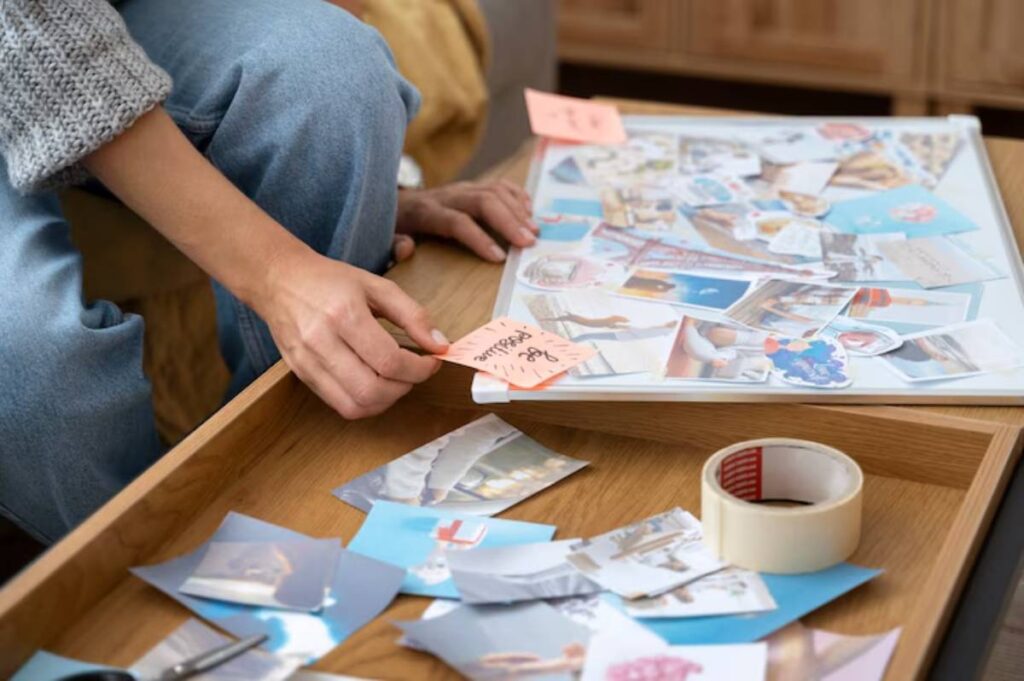The Personal Development Blog

How Often Should You Update a Vision Board?
There’s something quietly powerful about creating a vision board. It’s like telling the universe—or maybe just yourself—“Here’s what I’m reaching for.” But what happens after the glue dries or the Pinterest board is published? Do you leave it alone forever, hoping it still speaks your dreams into motion? Or do you revisit it, tweak it, maybe even reimagine it?
That’s where the question comes in: how often should a vision board be updated? How do you find the rhythm between letting it work and keeping it relevant?
In this article, let’s walk through when and why to do a vision board refresh, how to tie it into your goal tracking routine, and signs that it’s time to update your manifestation board—all without losing the magic that made you create it in the first place.
The Purpose of a Vision Board

Before we dive into timing, let’s pause for a moment on purpose.
A vision board isn’t just wall art or an aesthetic screensaver. It’s a psychological anchor—a visual trigger that reminds your brain where you’re headed and why it matters.
Good vision boards:
- Clarify values and goals
- Create emotional connection to those goals
- Encourage consistency through visual reinforcement
- Help your subconscious stay aligned with intentional choices
But here’s the thing: your life changes. And so should your board.
Signs It’s Time to Refresh
You don’t always need a calendar to know when to refresh. Often, the signs are more emotional than logistical.
Here’s what to look for:
1. You’ve Outgrown Your Current Goals
Maybe you reached them. Maybe they don’t excite you anymore. Either way, your board shouldn’t represent a version of you that no longer fits.
2. You Don’t Feel Anything When You Look at It
That spark? That emotional tug? If it’s gone, the board isn’t doing its job. You should feel connected—challenged, inspired, even a little nervous (in a good way).
3. You’re Avoiding It
If your eyes skim over it daily without a second thought, that’s your brain saying, “This doesn’t feel relevant anymore.”
4. Your Life Direction Has Shifted
A career change. A new relationship. A move. Big or small, life transitions often call for a re-anchoring.
5. You’re Feeling Stuck
If it seems like nothing on your board is moving forward, you might not need more effort—you might need a new vision.
How Often Should You Actually Refresh It?
Here’s the sweet spot: every 3 to 6 months.
Why that range?
- Three months gives you time to make progress, reflect, and pivot if needed.
- Six months is enough to prevent stagnation but still allow deeper goals to unfold.
Some people also align updates with natural checkpoints like:
- The start of a new year
- Quarterly goal reviews
- Birthdays or life anniversaries
- Seasons (spring reset, fall realignment, etc.)
There’s no perfect frequency—only the rhythm that keeps your board emotionally and strategically relevant.
For a more guided monthly system, explore Vision Board Reflection: Monthly Check-In Process.
How to Update a Manifestation Board Without Losing Momentum
You don’t have to start from scratch every time. In fact, sometimes a subtle shift speaks louder than a full overhaul.
Try These Approaches:
1. The Layering Method
Add new elements on top of the old. This works beautifully with corkboards or layered digital designs. It keeps your journey visible—like growth rings on a tree.
2. The “Archive and Replace” Approach
Retire elements that have served their purpose. Create a separate space (journal, envelope, digital file) to honour completed goals. Then refresh the board with new visions.
3. The Theme Tweak
Keep the board’s structure but change the dominant focus. Maybe your last board centred on career and now it’s time to spotlight relationships or personal joy.
4. Micro-Refreshes
Don’t wait for a full refresh. Add one quote. Swap one image. Let your board evolve as you do.
The Psychology Behind Refreshing
Your brain thrives on repetition, but it also craves novelty.
A vision board that never changes can become like background music—easy to tune out.
Refreshing your board does two key things:
- Reignites attention by introducing new stimuli
- Reinforces identity shifts by keeping visuals aligned with your current self
It’s not about chasing newness. It’s about staying congruent—ensuring that your board reflects who you’re becoming, not who you were when you first made it.
How to Tie It into a Goal Tracking Routine
If you’re someone who journals, uses planners, or sets quarterly intentions, updating your vision board can fold naturally into that rhythm.
Try this routine:
Monthly
- Glance at your board weekly
- Note progress or emotional reactions
- Add a sticky note with one focus word for the month
Quarterly
- Reflect on what’s shifted
- Refresh any goals that no longer resonate
- Add new visuals that align with where you’re going
Yearly
- Do a full reset if needed
- Create a “success archive” of what you’ve manifested or achieved
- Reconnect to your long-term vision
Making your board part of your goal-tracking routine transforms it from static art into a living tool.
Digital vs. Physical: Which One Is Easier to Update?
There’s no right answer here—but let’s break it down.
Digital Vision Board
- Easiest to update—drag, drop, delete, rearrange
- Tools like Canva or Pinterest make editing fast
- Great for people who change goals often
Physical Goal Board

- Takes more effort to refresh
- Offers deeper emotional satisfaction when updated
- Ideal for those who like tangible rituals
Whichever format you use, make sure the refresh process feels intuitive. If it feels like a chore, you’ll avoid it—and your board will lose its energy.
Want tools to help you revamp digitally? Try Free Online Vision Board Makers to Try.
Emotional Tips for Letting Go of Old Goals
Sometimes the hardest part of a vision board refresh isn’t adding something new—it’s removing what no longer fits.
If a goal hasn’t manifested, it can feel like failure. But here’s the truth: not all goals are meant to be lifelong companions.
Some were stepping stones. Others were placeholders. And a few were simply not yours to begin with.
When retiring a goal:
- Thank it for what it taught you
- Write a note to your past self about the experience
- Acknowledge the courage it took to want something, even if it didn’t come to pass
Growth isn’t about being right. It’s about being real.
Reframing the Manifestation Mindset
Refreshing your board isn’t a sign that manifestation “didn’t work.” It’s a signal that you’re paying attention.
Updating your manifestation board keeps your desires in harmony with your current identity. And that kind of self-awareness? That’s the most magnetic force of all.
Change Is the Point
A vision board is never finished. Not really.
Even when it’s perfect today, your dreams will stretch tomorrow. New ones will arrive unexpectedly. Old ones will dissolve gently. That’s not a flaw—it’s the entire point.
The best boards don’t stay static. They evolve. They reflect. They pulse with the rhythm of real life.
So go ahead—update it. Refresh it. Tear it apart if you have to. Not because you’re starting over, but because you’re still growing.
And that’s the most beautiful vision of all.









